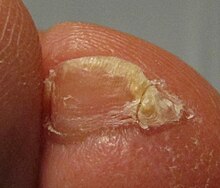
The accessory nail of the fifth toe, also known as a double nail of the fifth toe (DNFT) or a petaloid toenail, is a physical trait of the small toe, where a minuscule sixth toenail is present in the outer corner of the nail situated on the smallest toe. Although understudied and underreported, its prevalence is common.
Description
The accessory nail was first described in a 1969 paper by M. Hundeiker. The trait can be observed on either one or both feet where there is a lengthwise separation of the toenail on the corner of smallest toe. The smaller sixth toenail separates from the main toenail on the outermost side of the foot, and protrudes outwards from the corner. This nail averages 2–7 mm (0.079–0.276 in) in length. The additional nail can be cut with a nail clipper. Its occurrence is considered common but underreported.
The entire nail of the small toe is usually short and wide, and both nails often share the same nail bed.
Causes
The cause is poorly understood due to a lack of research, but genome-wide scans indicate that it is a heritable trait, and could be autosomal dominant. However, the wide variance in the size and structure of the accessory nail indicates that the trait may not follow a Mendelian pattern of inheritance, and may instead be a complex trait affected by multiple genes with minor genetic effects.
In some cases, the accessory nail presents with an abnormal protrusion or distortion of the fifth distal phalanx, or the splaying or rotation of the toe or entire foot. The trait may be a mild form of hexadactyly.
The condition may also appear following trauma to the toenail.
Diagnosis
Accesory toenails are often observed by the patient and diagnosed upon examination by a physician. X-rays are sometimes used to investigate the underlying bone structure for deformity. Ena et al. proposed the diagnostic criteria have 4 components: presence at birth, potential inheritance, involvement of the fifth toe, and bilaterality.
Differential diagnoses include trauma-induced short-term splits, ectopic nails, onychophosis, and calluses.
Treatment
Most people do not seek out treatment because the accessory nail typically does not cause pain or other symptoms that interfere with everyday activities. However, the condition can sometimes cause discomfort or pain, particularly when the accessory nail protrudes vertically from the nail bed. For those who do choose treatment, an option is surgical or chemical matricectomy (complete removal or destruction of the nail matrix).
Prevalence
Accessory toenails are observed in people from all ethnicities and races and are not more prevalent in one group than another. The condition is equally as common in both males and females.
They are stereotypically endemic to Han Chinese. Studies have suggested its prevalence in certain parts of China to be between 51% and 79%.
In mythology
Chinese mythology has it that during the time of the Yellow Emperor, there were two types of people living in China: those who were the descendants of the Yellow Emperor, and those who were nomadic Qiang people. The Henan people, led by Yin Wang, attacked the Qiang and abducted a Qiang woman, who later tried to escape. Yin Wang stabbed her in the abdomen as she tried to escape, so she gave birth to two children with a scar on the small toe of the foot. The children were taken back by Yin Wang for adoption, and their descendants were born with double nails on their small toes.
See also
- Congenital malformations of the dermatoglyphs
- Dominance (genetics)
- Epicanthic fold
- List of skin conditions
- Mongolian spot
References
- ^ Navarro Campoamor, L. (2021). "Double Nail of the Fifth Toe". Actas Dermo-Sifiliográficas (English Edition). 112 (2): 188–190. doi:10.1016/j.adengl.2020.12.026.
- ^ Chi CC, Wang SH (August 2004). "Inherited accessory nail of the fifth toe cured by surgical matricectomy". Dermatologic Surgery. 30 (8): 1177–9. doi:10.1111/j.1524-4725.2004.30351.x. PMID 15274716. S2CID 7930781.
- ^ Srivastava, Prakhar; Khunger, Niti (23 February 2023). "A Curious Case of Bilateral Double Fifth Toenails: Petaloid Nails". Indian Dermatology Online Journal. 14 (4): 556–557. doi:10.4103/idoj.idoj_444_22. PMC 10373832. PMID 37521208.
- ^ Haneke E (May 2016). "Double Nail of the Little Toe". Skin Appendage Disorders. 1 (4): 163–7. doi:10.1159/000443378. PMC 4908446. PMID 27386457.
- ^ Zhang MF, Wu SJ, Zhang J, Yang YJ, Tan JZ, Guan HJ, Liu Y, Tang K, Krutmann J, Xu SH, Jin L, Guan YQ, Li H, Wang SJ (20 December 2016). "Large-scale genome-wide scans do not support petaloid toenail as a Mendelian trait". Journal of Genetics and Genomics. 43 (12): 702–704. doi:10.1016/j.jgg.2016.10.003. PMID 27964859.
- Ena, Pasquale; Ena, Luca; Ferrari, Marco; Sotgiu, M Alessandra; Mazzarello, Vittorio (26 March 2020). "Double little toenails: Report of 4 familial cases". JAAD Case Reports. 6 (4): 365–368. doi:10.1016/j.jdcr.2020.02.008. PMC 7109568. PMID 32258324.
- "Definition of Matricectomy". MedicineNet. Archived from the original on 28 February 2018. Retrieved 27 February 2018.
- ^ Hao, Weiguo; Bian, Jianchao; Zhu, Ping (2005). "瓣状甲的类型、分布与遗传方式——对陕西周至县某村的调查" [Petaloid toenails: its types, distribution and hereditary mode:a survey of a Village in Zhouzhi County, Shaanxi Province, China]. Acta Anthropologica Sinica (in Chinese). 24 (4): 319–327. ISSN 1000-3193. Retrieved 27 December 2024.
- "关于小脚趾两瓣趾甲的传说]" [Regarding the myth of the double toenail] (in Chinese). Archived from the original on 10 June 2019.
Further reading
- Hundeiker, M. (1969). "Hereditäre Nageldysplasie der 5. Zehe" [Hereditary dysplasia of the 5th toe]. Hautzart (in German). 20 (6): 281–282. PMID 5355969.